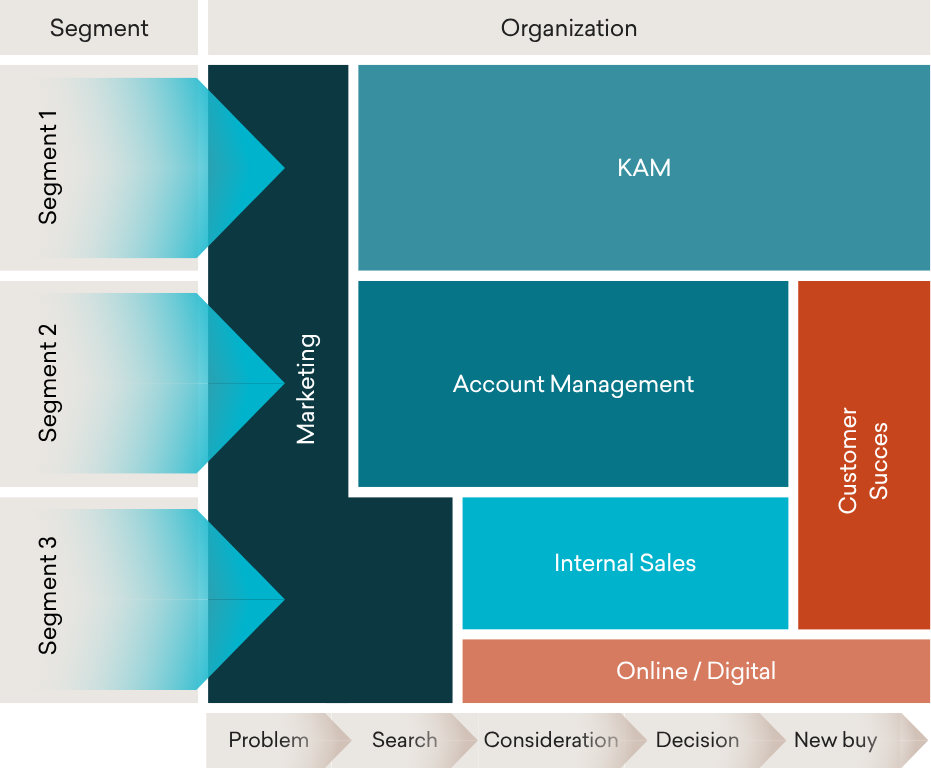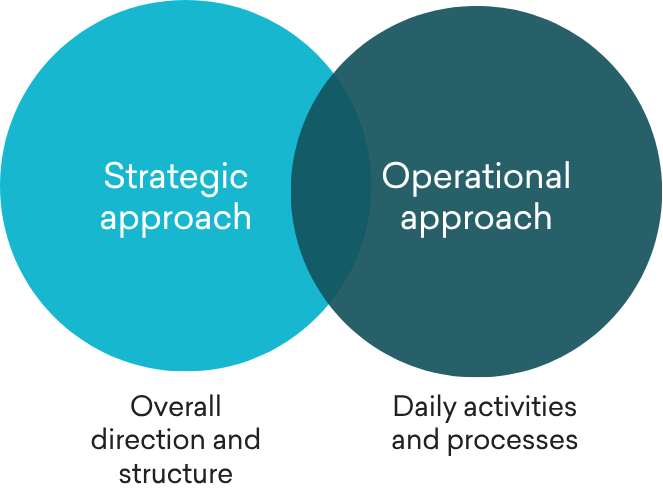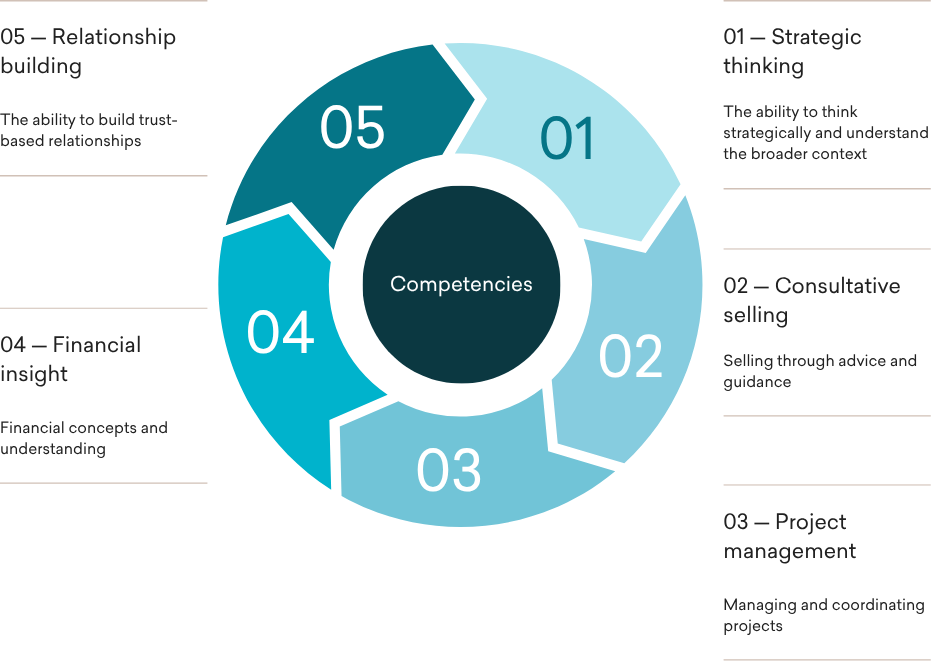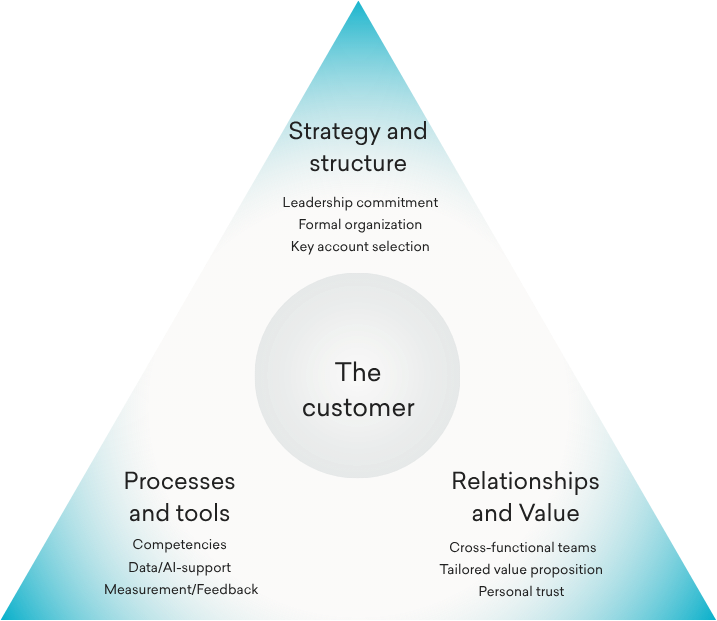Research-based report on sales
Key Account Management as a strategic discipline
Content
In today’s B2B sales environment, relationships with key customers are more critical than ever — not just for driving sales and results, but for the success of the entire business.
Key Account Management
KAM is a strategic discipline where sales organizations deliberately nurture and develop relationships with key customers.
And it works.
In fact, studies show that an effective KAM program can increase profitability by up to 15%. For you as a sales director or sales manager, that means KAM isn’t just a sales tactic. It’s a strategic investment in your most important customers — aligned with your overall business goals.
This report is for you who hold strategic responsibility for sales — whether you’re a CEO, CSO, or a strategic decision-maker.
The goal? To provide insight into modern KAM practices and offer guidance on how to strengthen your KAM function.
This report is developed in collaboration between Karina Burgdorf Jensen, associate professor of sales, and Intenz.
Why Key Account Management?
Several factors are driving the critical importance of KAM in today’s B2B sales. Customers have become fewer — but larger. Many operate globally. A small number of key accounts represent a large share of both revenue and growth potential.
And customers like these expect more: tailored solutions, support, strategic dialogue, and high-level attention.
KAM offers a structured and systematic approach to meet those expectations — with dedicated Key Account Managers and cross-functional teams focused on strategic customers.
But implementing KAM is demanding. It requires investment of time and resources, and it often involves changes to structures and processes.
One thing is clear, though: sales organizations are no longer asking if they should focus on key accounts — but how.
Strategic KAM in practice — a research-based guide in three parts:
Understanding KAM
KAM – a targeted discipline
KAM is a focused discipline in which the sales organization identifies its most important customers — key accounts — and assigns them special attention.
In practice, this means appointing dedicated Key Account Managers and building cross-functional teams around these customers. The goal is to establish deeper relationships and create mutual long-term value.
The purpose of KAM is to ensure that the largest customers experience tailored service, proactive collaboration, and strategic partnership — increasing loyalty and unlocking shared growth opportunities.
In this way, KAM differs from traditional sales through its long-term focus and high level of customization to each customer’s needs and strategies.
KAM is most relevant in sales organizations with a concentrated customer landscape, where a handful of clients account for a significant share of revenue or strategic development.
Research shows that in many industries, the top 5–10% of customers generate a disproportionately large share of revenue. In such situations, it becomes business-critical to manage these relationships with particular care.
KAM is especially important when customers operate in complex value chains, have global operations, or place high demands on integration and innovation from their suppliers. For example, if a customer requests customization, joint product development, or strategic collaboration, a KAM approach is clearly appropriate.
KAM is also relevant when there is potential for mutual growth — by investing in a key account, the supplier can gain greater loyalty, increase cross-selling, and even co-develop new solutions, creating opportunities for growth on both sides.

In sales organizations with thousands of small customers and highly standardized products, applying KAM may be inefficient, as the cost of offering tailored service to each customer does not justify the return. If no customers represent a significant share of the business or demand special attention, a traditional segmented sales model may be sufficient.
KAM requires focus and prioritization — if applied too broadly, there’s a risk of spreading resources too thin. That’s why companies should clearly define the criteria for what qualifies as a key account and apply the KAM approach only where it holds the greatest strategic value. Customers that don’t meet the criteria are better managed through standard sales models.
KAM may also be irrelevant if the organization isn’t ready for it — for example, if leadership doesn’t support the initiative, or if internal processes and capabilities to support key account work are lacking. In such cases, the sales organization should first build maturity before launching a KAM program.

The strategic importance of KAM
When the conditions for KAM are in place (meaning that true key accounts have been identified and deeper partnerships offer clear value), KAM becomes a strategic necessity.
Why? Because KAM creates structure and focus in managing the most important relationships, which can give the company a competitive advantage.
Research confirms that a well-functioning KAM program not only increases sales, but also strengthens the quality and longevity of customer relationships. In this way, KAM can drive greater customer loyalty — which in turn protects long-term profitability.
In today’s B2B sales environment, where customers expect partners rather than just suppliers, KAM is a powerful tool for meeting those expectations.
That said, it’s important to emphasize: KAM should not be implemented by default. It must make strategic sense and be supported by the right conditions in order to create real value.

A successful KAM-effort requires both a strong strategic foundation and effective operational execution.
The strategic approach concerns how KAM is integrated into the overall direction and structure of the sales organization, while the operational approach focuses on the day-to-day activities and processes involved in customer management. In this section, we explore both levels and the interaction between them.

A successful Key Account Management (KAM) effort requires both a strong strategic foundation and effective operational execution.
The strategic approach concerns how KAM is integrated into the overall direction and structure of the sales organization, while the operational approach focuses on the daily activities and processes involved in customer management.
Here, we highlight both levels and the interplay between them.
For KAM to succeed, it must be anchored in the sales organization’s strategy and supported by top management. This means that the sales organization should treat KAM as a strategic program — not an ad hoc initiative.
The first step is to strategically identify and prioritize key accounts.
- Define clear criteria for what qualifies a customer as a “Key Account” (based on factors such as revenue potential, strategic fit, or market influence).
- Ensure alignment within the sales organization on these selections.
The second step is to integrate KAM into the overall business strategy.
- Align KAM objectives (e.g., growth targets for key accounts, joint innovation projects, or increased share of wallet) with the broader goals of the sales organization.
- Make sure everyone understands why key accounts matter — and how focusing on them contributes to the bigger picture.
Leadership involvement is crucial
A key strategic factor for succeeding with KAM? Leadership involvement. Active support from top management sends a clear internal signal that KAM is a priority.
Best practice is to appoint an executive sponsor for each key account — typically a C-level leader — who personally follows the relationship.This ensures that issues or opportunities are addressed quickly at a high level, and that resources are allocated when needed.
Research shows that sales organizations where top management is actively engaged in KAM achieve higher effectiveness in customer management.
Organizational anchoring of KAM
Strategic KAM is also about organizational anchoring: designing a KAM structure within the organization that includes clear roles, competencies, and governance processes. Some sales organizations establish a dedicated KAM unit or a Center of Excellence to coordinate best practices across departments.
The key point is that KAM must have a formal “home” within the organization — and that the KAM initiative is deliberately led rather than left to chance.
While strategy sets the direction, KAM plays out in everyday operations through a range of practical activities. Cross-functional collaboration is fundamental:
Effective KAM requires breaking down silos and assembling a team across relevant departments for each key account.
A key account team may include people from sales, marketing, customer service, product development, and more — depending on the customer’s needs and industry context. This ensures 360-degree service and leverages the full capacity of the sales organization to create value with the customer.
Operationally, each Key Account should have a structured Account Plan.

Having a formal KAM process creates discipline and clarity that guides the KAM effort. It may include annual strategic meetings with the customer, quarterly internal status meetings, and ongoing follow-up through tools like dashboards.
Research highlights that formalized processes can improve performance — as long as there is enough flexibility to adapt to the customer.
KAM Managers must therefore also have the mandate to exercise judgment and adjust plans when customer needs change.
Competencies and tools
Another operational key is investing in competencies and tools. The individuals managing key accounts must be equipped with competencies that go beyond traditional sales skills.

A 2022 study found that the criteria for success among Key Account Managers differ from those of traditional salespeople. Why? Because Key Account Managers must more often navigate complex decision-making units and create long-term value in close relationships with key customers — all to support the customer’s strategic goals.
That’s why sales organizations should invest in targeted training and development of their KAM teams — and consider establishing KAM training programs or competency centers to ensure the continuous development and education of Key Account Managers.
What do we know works?
With decades of research and practical experience behind us, we know which approaches typically lead to success in KAM — and which ones often fail. We want to share that knowledge.
Below is a summary of some of the key do’s and don’ts, based on solid evidence.
Success criteria and best practices
A recurring theme in the KAM literature is the importance of executive engagement and cross-functional integration.
As mentioned earlier, KAM programs that enjoy active support from top management and involve multiple departments consistently deliver significantly better results.
In a comprehensive study of various KAM approaches, sales organizations with top-driven and coordinated KAM achieved the highest levels of internal efficiency and key account growth.
Put simply:
KAM works best when it is intentionally designed as a strategic program — with leadership support, clear processes, and involvement across the entire organization.
Concrete practices that work in KAM
Clear customer focus
Clearly define who the key accounts are — and continuously review the list to ensure resources are focused where the return is highest.
Strategic anchoring
KAM goals, activities, and resources are directly aligned with the sales strategy, ensuring the entire organization pulls in the same direction.
Executive sponsorship
Top management acts as a sponsor for each key account and participates in critical meetings to elevate the relationship to a partnership level.
Cross-functional teams
Silos are broken down; sales, production, service, and others work from a shared customer plan with clearly defined roles and structured meeting schedule.
Structures & tools
Regular customer reviews, standardized account plans, and consistent CRM usage make efforts scalable and transparent.
Competency development
Ongoing training and mentoring programs build skills in strategic selling, negotiation, and relationship management.
Data-driven insight
Analytics, AI, and customer portals provide early insight into customer needs and enable real-time collaboration.
Personal relationships and trust
Despite technology, successful KAMs maintain a strong focus on the human relationship. Frequent personal contact — ideally through visits or at least video calls — is prioritized to build trust.
Metrics & learning
KPIs on growth, profitability, and customer satisfaction, along with feedback from won/lost deals, are actively used for continuous improvement.
Evidence-based KAM program
The best practice model for Key Account Management is evidence-based. It draws on the characteristics of the most successful KAM programs observed in sales research.

Sales organizations that designed their KAM programs with these elements achieved, as mentioned, both higher internal efficiency (the team meets its account goals and collaborates smoothly) and better customer outcomes (greater growth, retention, and satisfaction).
KAM-maturity
Assessing KAM-maturity
02
Not all organizations are at the same level when it comes to KAM. Some are just launching their first key account initiatives, while others have years of experience and well-tuned processes. To target improvements effectively, it’s useful to assess the maturity of your KAM efforts.
Dimensions of maturity
A maturity assessment should cover multiple dimensions of the KAM function, as maturity may vary across different aspects.

When each dimension is assessed on a maturity scale (e.g., 1 to 5, where 1 is low and 5 is optimal), an organization can generate a radar chart or scorecard of its KAM maturity.
The questions and scoring are calibrated using empirical data.
Validity and Purpose
The maturity model is not an end in itself — it’s a means to an end.
The goal is to improve KAM performance. The maturity score simply helps identify the gap between the current state and best practice, enabling a targeted transformation plan.
And that brings us to the next part of the report: How can an organization transform its KAM efforts — whether starting from low maturity or aiming to move from good to world-class.
Transforming KAM
From knowledge to implementation
Improving or reinventing an organization’s KAM program is a change journey that requires a structured approach.
Three phases guide a sales organization through the process — from initial insight to a new KAM approach.
Phase 1: Knowledge
The knowledge phase is about building understanding. Insight, alignment, and planning must be in place before major changes are launched. This stage is about knowing what and why — establishing a solid decision-making foundation and securing commitment from key stakeholders.
Key elements in the knowledge phase:
- Analysis of the current KAM state
- Best practices, inspiration, and learning
- Vision and goals for KAM
- Stakeholder buy-in
- Development of KAM strategy and roadmap
The output of the knowledge phase is a strong foundation to move forward with, including:
- A shared understanding across the organization of why KAM transformation is necessary and valuable (“case for change”)
- A clear vision and defined goals for the future KAM program
- A plan for how the transformation will be executed
Phase 2: Design
The design phase is about preparing the organization — making sure everything is in place to put the plan into action.
Here, the change is built from the inside out.
Key elements in the design phase:
- Organizational changes
- Cross-functional teams and governance
- Process implementation
- IT and tool support
- Competency development, training, and culture
- Pilot projects (internal focus)
By the end of the design phase, the organization should be internally “battle-ready”: the right people are in place, they know what to do, and they have the necessary tools.
The concept has been tested on a small scale and adjusted to reduce the risk of major failures.
Now it’s time to turn the focus outward — toward the customers — in the implementation phase.
Phase 3: Implementation
The implementation phase is the real test: executing the new KAM setup in practice.
While the design phase was about preparing the organization, implementation is about doing the work with customers and ensuring that improvements actually take place and become anchored.
Key elements in the implementation phase:
- Roll-out to key accounts
- Monitoring and evaluation
- Coaching and support
- Quick wins and motivation-building
- Adjustment and continuous improvement
The goal is a fully functioning, best-practice-inspired KAM program in operation — and the first results begin to show, perhaps in the form of stronger relationships and an increased pipeline.
KAM continues to evolve, but the main transformation project is complete, and KAM has become an integrated part of how the sales organization does business with its most important customers.
Key Account Management is one of the most powerful drivers of growth in B2B sales — but only when done right.
In this report, we’ve covered the full picture: what KAM is, why it matters, how it works, and what it requires from your organization. We’ve explored both best practices and a concrete framework to assess and transform your KAM efforts.
The research is clear: the best-performing sales organizations work in a focused and structured way with their most important customers. They secure executive backing. They build cross-functional teams. They use data. And they invest in long-term relationships.
Digitalization and AI will undoubtedly shape the future of KAM. But the organizations that succeed will be those that adopt new technologies as enablers — and still maintain the human connection at the core of their customer relationships.
For you as a CEO, CSO, or sales leader, this means one thing: making sure your sales organization is mature enough in its KAM approach to meet the demands of complex customers — today and in the future. That requires an honest look at where you fall short, and the courage to lead the necessary transformations.
But both experience and evidence show that it pays off. The rewards are significant for those who commit: greater customer loyalty, increased revenue, and closer collaboration with key accounts — paving the way for innovation and shared success.
The key is to combine knowledge — both internal and research-based — with action. We’ve aimed to deliver both: by summarizing the latest insights on what works in KAM, and by translating them into a practical offering and roadmap.
The next step now lies with each individual organization. It’s about taking these insights and adapting them to your own reality. With leadership commitment, the right competencies, and persistence, any sales organization can elevate its KAM maturity.
Customer relationships are valuable assets. They are not something you simply have — they must be developed and maintained. A strengthened KAM effort is not just a sales optimization — it is a strategic necessity for long-term, sustainable success in the B2B market.
